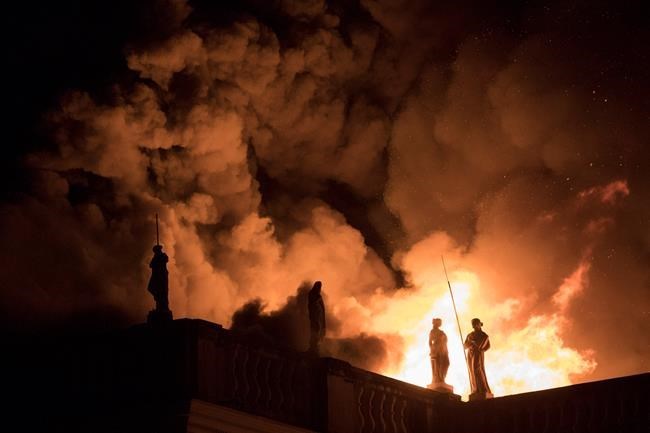
FILE - In this Sept. 2, 2018 file photo, flames engulf the 200-year-old National Museum of Brazil, in Rio de Janeiro. Federal police say an air conditioning unit is the “primary cause” of the fire that destroyed Brazil’s National Museum in Rio de Janeiro. Fire experts have presented the conclusions of a seven-month investigation into the Sept. 2, 2018 fire, which began in the museum’s auditorium and quickly spread to the rest of the building, destroying most of its 20 million artifacts. (AP Photo/Leo Correa, File)
Republished April 04, 2019 - 12:56 PM
Original Publication Date April 04, 2019 - 10:26 AM
RIO DE JANEIRO - An air conditioning unit was the "primary cause" of a fire that destroyed Brazil's National Museum and most of its 20 million artifacts, police experts said Thursday.
The larger investigation into the Sept. 2 tragedy is still ongoing, but experts released their findings on the origin and location of the blaze.
"There was various pieces of evidence that allowed us to conclude that the (air conditioning unit) was the primary cause of the fire", expert Marco Antonio Zatta said during a news conference in Rio de Janeiro.
Temperatures rose above 1,000 degrees centigrade in the museum auditorium where the fire began, experts said, creating such damage that it wasn't possible to determine why the air conditioning unit caught fire.
But Zatta said the units there were receiving a stronger electrical current than they were designed to handle.
Federal police experts also stressed that aside from fire extinguishers, the museum lacked most recommended fire protection devices, such as hoses, sufficient water sprinklers and fire doors.
According to the Open Accounts non-profit that tracks spending, the museum had spent only $4,000 on safety equipment from 2015 to 2017.
The museum held Latin America's largest collection of historical artifacts. After the fire, researchers retrieved a fraction of the museum's collection, including skull fragments belonging to "Luzia", the name given to a woman who lived 11,500 years ago.
Efforts to reconstruct the facility are underway, beginning with the restoration of the facade.
News from © The Associated Press, 2019